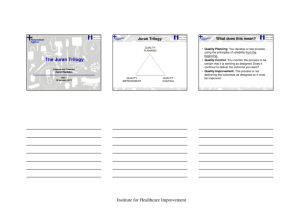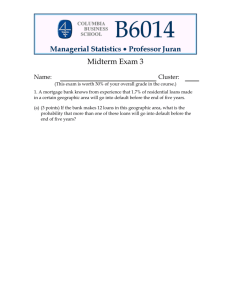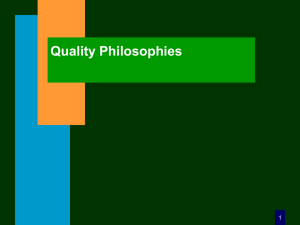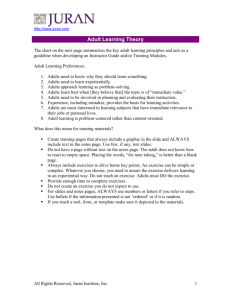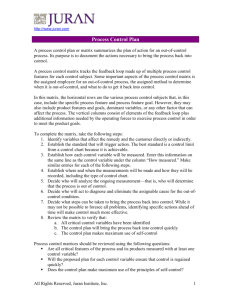om-01a - NYU Stern School of Business
advertisement
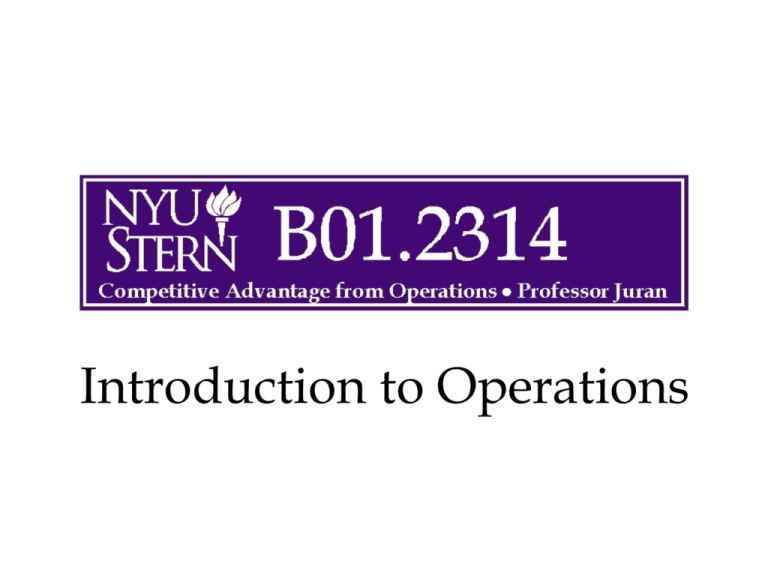
Introduction to Operations Outline • • • • • • • • Intro to Operations Management Administrative Issues Basic Definitions Historical Development of OM Scientific Management Current Issues in OM Operations Strategy Measures of Productivity Operations -- Prof. Juran 2 ©The McGraw-Hill Companies, Inc., 2004 About the Class • Web site – – – – Mission Description Syllabus (note special dates) Downloads • Textbook • TA Operations -- Prof. Juran 3 ©The McGraw-Hill Companies, Inc., 2004 What is Operations Management? The design, control, and improvement of the systems that create and deliver the firm’s primary products and services Operations -- Prof. Juran 4 ©The McGraw-Hill Companies, Inc., 2004 What is a Production System? A user of resources to transform inputs into some desired outputs Operations -- Prof. Juran 5 ©The McGraw-Hill Companies, Inc., 2004 Important Measures of Performance Efficiency: Using a minimum of resources Effectiveness: Creating value for some customer Operations -- Prof. Juran 6 ©The McGraw-Hill Companies, Inc., 2004 Transformations Physical Locational Exchange Storage Physiological Informational Operations -- Prof. Juran (Manufacturing) (Transportation) (Retailing) (Warehousing) (Health Care) (Telecommunications) 7 ©The McGraw-Hill Companies, Inc., 2004 Manufacturing vs. Services What differentiates manufacturing operations from service operations? J&C proposition: All businesses are services Operations -- Prof. Juran 8 ©The McGraw-Hill Companies, Inc., 2004 Historical Development of OM • • • • • • • • Craft System Industrial Revolution Scientific Management Organizational Science Operations Research JIT and TQM Supply Chain Management Internet Commerce Operations -- Prof. Juran 9 ©The McGraw-Hill Companies, Inc., 2004 Craft System Operations -- Prof. Juran 10 ©The McGraw-Hill Companies, Inc., 2004 Industrial Revolution Eli Whitney (1765 – 1825) Operations -- Prof. Juran 11 ©The McGraw-Hill Companies, Inc., 2004 Scientific Management Frederick W. Taylor (1856 – 1915) Operations -- Prof. Juran 12 ©The McGraw-Hill Companies, Inc., 2004 Industrial Revolution Henry Ford (1863 – 1947) Operations -- Prof. Juran 13 ©The McGraw-Hill Companies, Inc., 2004 Organizational Science Elton Mayo (1880 - 1949) Operations -- Prof. Juran 14 ©The McGraw-Hill Companies, Inc., 2004 Operations Research Patrick Blackett (1897 - 1974) Operations -- Prof. Juran 15 ©The McGraw-Hill Companies, Inc., 2004 JIT and TQM Taiichi Ohno (1912 – 1990) Operations -- Prof. Juran Kaoru Ishikawa (1915 – 1989) Genichi Taguchi (1924 – 2012) 16 ©The McGraw-Hill Companies, Inc., 2004 JIT and TQM Walter Shewhart (1891 – 1967) Operations -- Prof. Juran W. Edwards Deming (1900 – 1993) Joseph M. Juran (1904 – 2008) 17 ©The McGraw-Hill Companies, Inc., 2004 Current Issues in OM • Effectively consolidating the operations resulting from mergers • Developing flexible supply chains to enable mass customization of products and services • Managing global supplier, production and distribution networks • Increased “commoditization” of suppliers Operations -- Prof. Juran 18 ©The McGraw-Hill Companies, Inc., 2004 Current Issues in OM (cont’d) • Achieving the “Service Factory” • Enhancing value added services • Making efficient use of Internet technology • Achieving good service from service firms • Operational risk • Reduced environmental impact • Reduced energy consumption Operations -- Prof. Juran 19 ©The McGraw-Hill Companies, Inc., 2004 Operations Strategy J&C: Setting broad policies and plans for using the resources of the firm to best support its long-term competitive strategy Juran: Deciding how the firm’s competitive strategy will actually happen, in terms of processes that are more efficient and/or more effective than the competition’s processes. Operations -- Prof. Juran 20 ©The McGraw-Hill Companies, Inc., 2004 Operations Strategy Key questions: •What business are we in? •Who are the customers? •What do the customers need? •How can we meet those needs more efficiently/effectively than the competition? •How is all of this going to change over time? Operations -- Prof. Juran 21 ©The McGraw-Hill Companies, Inc., 2004 Competitive Dimensions • Cost • Product Quality and Reliability • Delivery Speed • Delivery Reliability • Coping with Changes in Demand • Flexibility and New Product Introduction Speed • Other Product-Specific Criteria Operations -- Prof. Juran 22 ©The McGraw-Hill Companies, Inc., 2004 Dealing with Trade-offs •Cost vs. Quality •Flexibility vs. Speed •Etc. Operations -- Prof. Juran 23 ©The McGraw-Hill Companies, Inc., 2004 Strategic Frameworks Kaplan and Norton: •Financial •Customer •Internal •Learning and Growth Operations -- Prof. Juran 24 ©The McGraw-Hill Companies, Inc., 2004 Strategic Frameworks Michael Porter: •Rivalry •Threat of Substitutes •Buyer Power •Supplier Power •Barriers to Entry / Threat of Entry Operations -- Prof. Juran 25 ©The McGraw-Hill Companies, Inc., 2004 What is Productivity? Productivity is a common measure on how well resources are being used. In the broadest sense, it can be defined as the following ratio: Outputs Inputs Operations -- Prof. Juran 26 ©The McGraw-Hill Companies, Inc., 2004 Total Measure Productivity Total Measure Productivity = Outputs Inputs or = Goods and services produced All resources used Operations -- Prof. Juran 27 ©The McGraw-Hill Companies, Inc., 2004 Partial Measure Productivity Output or Output or Output or Output Labor Capital Operations -- Prof. Juran Materials Energy 28 ©The McGraw-Hill Companies, Inc., 2004 Multifactor Measure Productivity Output Labor + Capital . + Energy or Output Labor + Operations -- Prof. Juran Capital . + Materials 29 ©The McGraw-Hill Companies, Inc., 2004 Summary • • • • • • • • Intro to Operations Management Administrative Issues Basic Definitions Historical Development of OM Current Issues in OM Operations Strategy Measures of Productivity Scientific Management Operations -- Prof. Juran 30 ©The McGraw-Hill Companies, Inc., 2004
